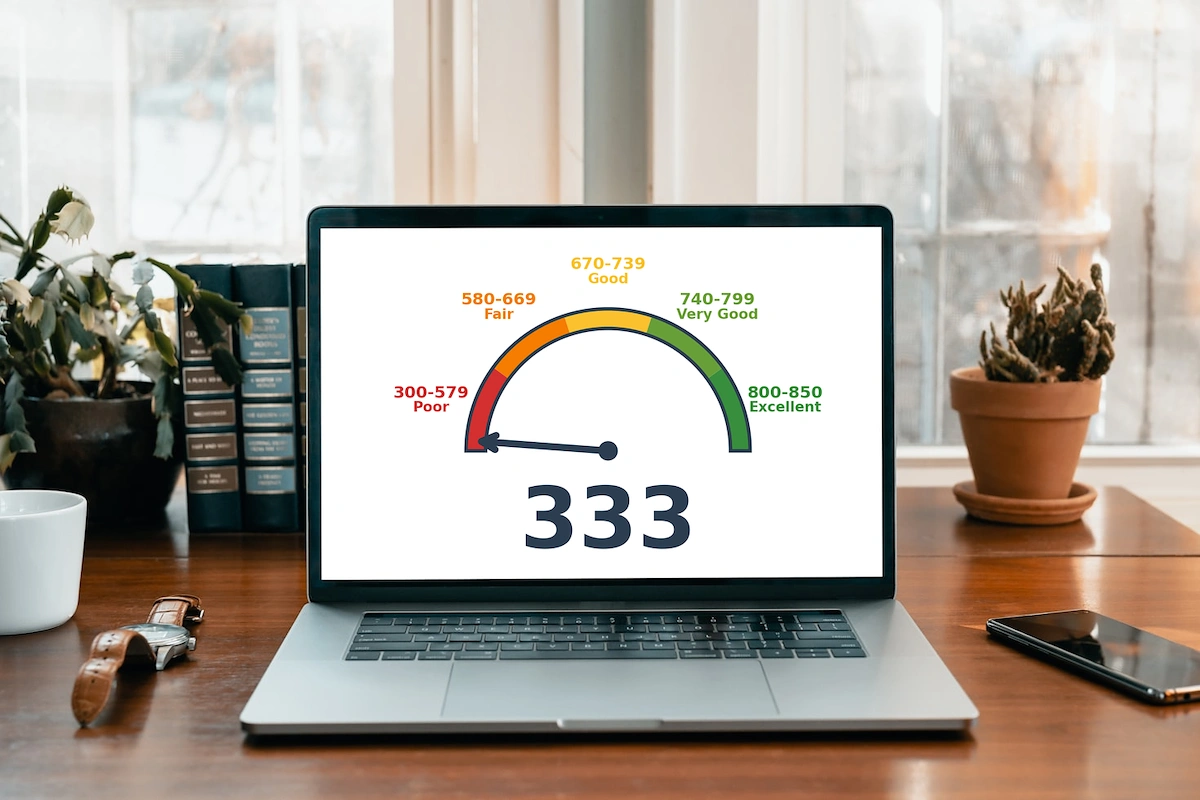
Kudos has partnered with CardRatings and Red Ventures for our coverage of credit card products. Kudos, CardRatings, and Red Ventures may receive a commission from card issuers. Kudos may receive commission from card issuers. Some of the card offers that appear on Kudos are from advertisers and may impact how and where card products appear on the site. Kudos tries to include as many card companies and offers as we are aware of, including offers from issuers that don't pay us, but we may not cover all card companies or all available card offers. You don't have to use our links, but we're grateful when you do!
333 Credit score: What You Need to Know in 2025
July 1, 2025


TL;DR
While a 333 credit score presents significant hurdles, it provides a clear baseline from which to build a stronger financial foundation. This score falls squarely within the "Poor" FICO score category, marking the very beginning of the journey toward excellent credit.
What Does a 333 Credit Score Mean?
A credit score of 333 falls into the "very poor" category of the FICO Score range, which spans from 300 to 850. This score signals significant risk to lenders, making it extremely difficult to get approved for new credit like loans or credit cards. Any approvals you do receive will likely come with steep interest rates and unfavorable terms, making borrowing much more expensive.
While this score presents considerable financial challenges, it's not a permanent label. It represents a starting point for rebuilding your credit. Understanding the factors that contributed to this score is the first step toward making positive changes. Over time, it is possible to improve your standing and gain access to better financial products.
Who Has a 333 Credit Score?
While age isn't a direct factor in calculating your credit score, there is a clear correlation between age and average scores. According to an analysis of average credit scores by generation, scores tend to increase over time as individuals build a longer credit history. Here is the breakdown of average FICO scores from 2023:
- Generation Z (ages 18-26): 680
- Millennials (ages 27-42): 690
- Generation X (ages 43-58): 709
- Baby Boomers (ages 59-77): 745
- Silent Generation (ages 78+): 760
Credit Cards With a 333 Credit Score
A credit score of 333 falls into the "very poor" range, signaling to lenders that you are a high-risk borrower. Consequently, you'll likely face significant challenges when applying for traditional unsecured credit cards, with most mainstream issuers denying your application outright. Your options will generally be limited to secured credit cards that require a cash deposit or specific subprime cards designed for rebuilding credit, which often come with high fees and interest rates.
Kudos can help you find a suitable card using its AI-powered Explore Tool, which personalizes recommendations from nearly 3,000 options based on your financial preferences. To further assist, the platform provides credit score insights, helping you understand the potential impact of a new card on your financial health.
Auto Loans and a 333 Credit Score
A 333 credit score places you in the deep subprime category, making it difficult, though not impossible, to secure an auto loan. Lenders view this score as high-risk, which means you will face significantly higher interest rates than borrowers with better credit.
For context, here is how average auto loan rates break down by credit score, based on a 2025 market analysis:
- Super-prime (781-850): 5.25% for new cars and 7.13% for used cars
- Prime (661-780): 6.87% for new cars and 9.36% for used cars
- Non-prime (601-660): 9.83% for new cars and 13.92% for used cars
- Subprime (501-600): 13.18% for new cars and 18.86% for used cars
- Deep subprime (300-500): 15.77% for new cars and 21.55% for used cars
Mortgages at a 333 Credit Score
A 333 credit score is considered very low and unfortunately falls below the minimum requirements for any standard mortgage. For example, conventional loans typically require a score of at least 620. Even the most flexible government-backed FHA loans have a minimum score of 500, and that’s only with a 10% down payment. According to mortgage requirements, a score this low makes you ineligible for mainstream financing.
The primary impact of a 333 credit score is ineligibility, meaning you won't be offered loan terms by most lenders. While lower scores generally lead to higher interest rates and fees, a score this far below the minimum means you won't get an offer at all. Your only potential avenues might be risky, non-traditional options like owner financing, which are not regulated like standard mortgages.
What's in a Credit Score?
Understanding your credit score can feel like trying to solve a complex puzzle, as it's a blend of several key financial habits. The most common factors that determine your score include:
- Your payment history tracks whether you have paid past credit accounts on time.
- Credit utilization is the percentage of your available credit that you are currently using.
- The length of your credit history considers the age of your oldest account and the average age of all your accounts.
- Credit mix refers to the variety of credit products you have, such as credit cards, retail accounts, and loans.
- New credit inquiries and recently opened accounts can also temporarily impact your score.
How to Improve Your 333 Credit Score
Having a 333 credit score can feel discouraging, but it is absolutely possible to improve it. By taking consistent, positive steps, most people can see meaningful changes to their score within three to six months.
- Make on-time payments. Your payment history is the single most important factor in your credit score, so establishing a track record of paying on time is critical. Setting up automatic payments for all your bills is a foolproof way to ensure you never miss a due date and begin rebuilding your credit.
- Apply for a secured credit card. A secured card is designed for individuals with damaged or limited credit and can be a powerful tool for rebuilding. Since these cards report your payment activity to the major credit bureaus, consistent, responsible use helps establish the positive history needed to raise your score.
- Monitor your credit reports. It's essential to regularly check your credit reports for inaccuracies or fraudulent activity that could be dragging your score down. Disputing and removing errors is one of the fastest ways to achieve a score increase, especially when starting from a very low number.
- Reduce your credit utilization ratio. This ratio measures how much of your available credit you're using, and keeping it below 30% is crucial for a healthy score. For someone with a low score, this means focusing on paying down existing balances to improve this key scoring factor.
The Kudos browser extension can help you manage your credit cards and make smarter financial decisions on your credit improvement journey.

Supercharge Your Credit Cards
Experience smarter spending with Kudos and unlock more from your credit cards. Earn $20.00 when you sign up for Kudos with "GET20" and make an eligible Kudos Boost purchase.
Editorial Disclosure: Opinions expressed here are those of Kudos alone, not those of any bank, credit card issuer, hotel, airline, or other entity. This content has not been reviewed, approved or otherwise endorsed by any of the entities included within the post.




























.webp)
.webp)
.webp)
%20(1).webp)
.webp)


.webp)
.webp)
%20(1).webp)